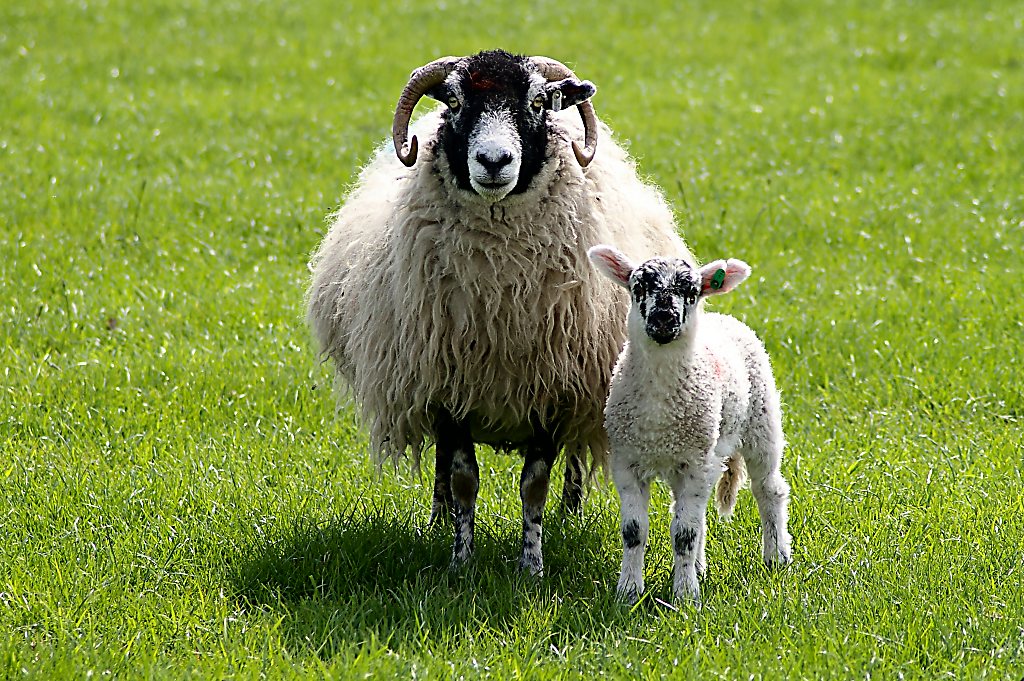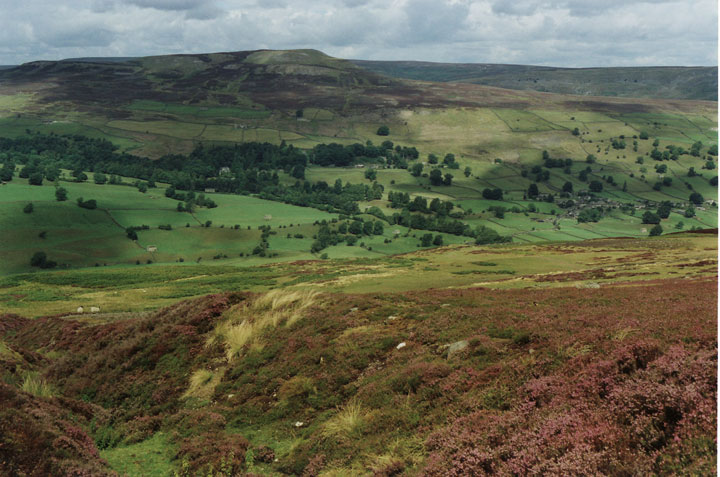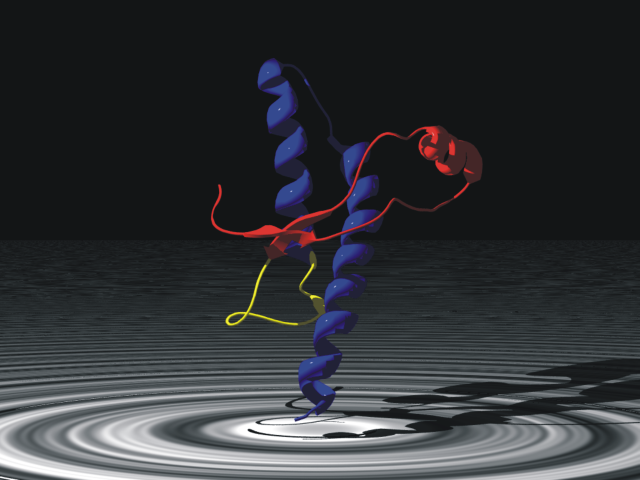|
Swaledale Sheep
Swaledale is a breed of domestic sheep named after the Yorkshire valley of Swaledale in England. They are found throughout the more mountainous areas of Great Britain, but particularly in the Yorkshire Dales, County Durham, and around the pennine fells of Cumbria. Swaledales are noted for their off-white wool, curled horns and white around their nose and eyes. They are used for the production of lamb/mutton, the North of England Mule sheep, and as Pedigree breeding stock. Together with the Rough Fell, Herdwick, and Dalesbred sheep, they are one of the four variations associated with the English Lake District. Breed characteristics Well suited to the exposed regions in which they predominantly live, the Swaledales are very hardy, thick coated, able bodied, and bold. The ewes make excellent mothers and are known for being able to rear lambs well, even in adverse conditions. They are of a medium build, with black faces marked with bright white around the nose and eyes. Males a ... [...More Info...] [...Related Items...] OR: [Wikipedia] [Google] [Baidu] |
Swaledale Mother And Lamb
Swaledale is one of the northernmost dales (valleys) in Yorkshire Dales National Park, located in northern England. It is the dale of the River Swale on the east side of the Pennines in North Yorkshire. Geographical overview Swaledale runs broadly from west to east, from the high moors on the Cumbria–Yorkshire boundary at the watershed of Northern England to the market town of Richmond, where the dale meets the lowlands. Nine Standards Rigg, the prominent ridge with nine ancient tall cairns, rises on the watershed at the head of Swaledale. To the south and east of the ridge a number of smaller dales (Birkdale, Little Sleddale, Great Sleddale and Whitsundale) join to form the narrow valley of upper Swaledale at the small village of Keld. From there, the valley runs briefly south then turns east at Thwaite to broaden progressively as it passes Muker, Gunnerside, Low Row, Healaugh and Reeth. The Pennine valley ends at Richmond, where an important medieval castle still ... [...More Info...] [...Related Items...] OR: [Wikipedia] [Google] [Baidu] |
Argali
The argali (''Ovis ammon''), also known as the mountain sheep, is a wild sheep that roams the highlands of western East Asia, the Himalayas, Tibet, and the Altai Mountains. Description The name 'argali' is the Mongolian word for wild sheep. It is the largest species of wild sheep. Argali stand high at the shoulder and measure long from the head to the base of the tail. The female, or ewe is the smaller sex by a considerable margin, sometimes weighing less than half as much as the male, or ram. The ewes can weigh from and the rams typically from , with a maximum reported mass of . The Pamir argali (also called Marco Polo sheep, for they were first described by that traveler), ''O. a. polii'', is the largest race on average, regularly measuring more than long without the tail, and is less sexually dimorphic in body mass than most other subspecies. The argali has relatively the shortest tail of any wild goat-antelope or sheep, with reported tail lengths of . The general ... [...More Info...] [...Related Items...] OR: [Wikipedia] [Google] [Baidu] |
Bluefaced Leicester
The Bluefaced Leicester (BFL) is a longwool breed of sheep which evolved from a breeding scheme of Robert Bakewell, in Dishley, Leicestershire in the eighteenth century. First known as the Dishley Leicester, and then the Hexham Leicester, because of the prevalence of the breed in Northumberland, the name Bluefaced Leicester became known at the beginning of the 20th century. In the 1970s, the Bluefaced Leicester was exported to Canada. Exported frozen semen from the United Kingdom is now used to expand the genetic diversity in Canada and the United States. This breed is raised primarily for meat, but their fleece is becoming increasingly popular for handspinning. Bluefaced Leicester sheep may also have brown on their face. The sell record has been set by a brown ram lamb selling for 23,000 guineas. Characteristics BFL sheep have curly, fine, rather lustrous wool which is one of the softest of the UK clip. The fleeces are not very heavy, only weighing . They have no wool on ... [...More Info...] [...Related Items...] OR: [Wikipedia] [Google] [Baidu] |
Mule (sheep)
In sheep farming, the term mule is used to refer to a cross between a Bluefaced Leicester ram and a purebred hill (or mountain) ewe (usually a Swaledale sheep) . The production of such mule ewes is a widely used breeding management system which offers several advantages to the farmer. Cross breeding the hill ewe with the lowland ram brings about hybrid vigour or heterosis, which brings the best characteristics of both breeds into one ewe that can be used in producing lamb for the table. The hill ewe, for example the Scottish Blackface, is a hardy animal with good, natural mothering instincts. She is, however, not very prolific and tends to produce one lamb: suited to the harsh conditions. The lowland ram, such as the Blueface Leicester is prolific, producing ewes which give 1-3 lambs and capable of producing enough milk to rear them. The cross between the two, in this case the Scottish mule, has good mothering instincts, good sized lambs and prolific milk production. This mule ... [...More Info...] [...Related Items...] OR: [Wikipedia] [Google] [Baidu] |
Journal Of General Virology
''Journal of General Virology'' is a not-for-profit peer-reviewed scientific journal published by the Microbiology Society. The journal was established in 1967 and covers research into animal viruses, insect viruses, plants viruses, fungal viruses, prokaryotic viruses, and TSE agents. Antiviral compounds and clinical aspects of virus infection are also covered. Since 2020 the editor-in-chief is Paul Duprex (Centre for Vaccine Research, University of Pittsburgh), who took over from Professor Mark Harris (University of Leeds) who had served as Editor-in-Chief since 2015. Journal Article types ''Journal of General Virology'' publishes primary research articles, Reviews, Short Communications, Personal Views, and Editorials. Since 2017 the journal has partnered with the International Committee on Taxonomy of Viruses to publish Open Access ICTV Virus Taxonomy Profiles which summarise chapters of the ICTV’s 10th Report on Virus Taxonomy. All ICTV Virus Taxonomy Profiles are p ... [...More Info...] [...Related Items...] OR: [Wikipedia] [Google] [Baidu] |
Scrapie
Scrapie () is a fatal, degenerative disease affecting the nervous systems of sheep and goats. It is one of several transmissible spongiform encephalopathies (TSEs), and as such it is thought to be caused by a prion. Scrapie has been known since at least 1732 and does not appear to be transmissible to humans. However, new studies suggest a link between scrapie and sporadic Creutzfeldt–Jakob disease, CJD. The name scrapie is derived from one of the clinical signs of the condition, wherein affected animals will compulsively scrape off their fleeces against rocks, trees or fences. The disease apparently causes an itching sensation in the animals. Other clinical signs include excessive lip smacking, altered gaits and convulsive collapse. Scrapie is infectious and transmissible among conspecifics, so one of the most common ways to contain it (since it is incurable) is to quarantine and kill those affected. However, scrapie tends to persist in flocks and can also arise apparently sp ... [...More Info...] [...Related Items...] OR: [Wikipedia] [Google] [Baidu] |
Sheep
Sheep or domestic sheep (''Ovis aries'') are domesticated, ruminant mammals typically kept as livestock. Although the term ''sheep'' can apply to other species in the genus ''Ovis'', in everyday usage it almost always refers to domesticated sheep. Like all ruminants, sheep are members of the order (biology), order Artiodactyla, the even-toed ungulates. Numbering a little over one billion, domestic sheep are also the most numerous species of sheep. An adult female is referred to as a ''ewe'' (), an intact male as a ''ram'', occasionally a ''tup'', a castrated male as a ''wether'', and a young sheep as a ''lamb''. Sheep are most likely descended from the wild mouflon of Europe and Asia, with Iran being a geographic envelope of the domestication center. One of the earliest animals to be domesticated for agricultural purposes, sheep are raised for fleeces, meat (lamb, hogget or mutton) and sheep milk, milk. A sheep's wool is the most widely used animal fiber, and is usually harvest ... [...More Info...] [...Related Items...] OR: [Wikipedia] [Google] [Baidu] |
Hawes
Hawes is a market town and civil parish in the Richmondshire district of North Yorkshire, England, at the head of Wensleydale in the Yorkshire Dales, and historically in the North Riding of Yorkshire. The River Ure north of the town is a tourist attraction in the Yorkshire Dales National Park. The population in 2011 was 887. The parish of Hawes also includes the neighbouring hamlet of Gayle. Hawes is west of the county town of Northallerton. It is a major producer of Wensleydale cheese. Hawes has a non-profit group that seeks funding to re-open or keep community amenities. History There is no mention in the '' Domesday Book'' of a settlement where the current town is. The area was historically part of the large ancient parish of Aysgarth in the North Riding of Yorkshire, and there is little mention of the town until the 15th century when the population had risen enough for a chapel of ease to be built. The settlement was first recorded in 1307 as having a mar ... [...More Info...] [...Related Items...] OR: [Wikipedia] [Google] [Baidu] |
Kirkby Stephen
Kirkby Stephen () is a market town and civil parish in Cumbria, North West England. Historically part of Westmorland, it lies on the A685, surrounded by sparsely populated hill country, about from the nearest larger towns: Kendal and Penrith. The River Eden rises away in the peat bogs below Hugh Seat and passes the eastern edge of the town. At the 2001 census the parish had a population of 1,832. In 2011, it had a population of 1,522. Market In 1352–1353, Roger de Clifford, Baron of Westmorland, obtained a charter from King Edward III for a market and two annual fairs to be held in the town. This was reaffirmed by a charter granted in 1605 to George, Earl of Cumberland, by King James I, for "one market on Monday and two fairs yearly; one on the Wednesday, Thursday and Friday after Whitsuntide and the other on the two days next before the feast of St Luke." The Monday market, with livestock sales at the Mart in Faraday Road and stalls on Market Square, remains an i ... [...More Info...] [...Related Items...] OR: [Wikipedia] [Google] [Baidu] |
2015 Swaledale Sheep
Fifteen or 15 may refer to: * 15 (number), the natural number following 14 and preceding 16 *one of the years 15 BC, AD 15, 1915, 2015 Music *Fifteen (band), a punk rock band Albums * ''15'' (Buckcherry album), 2005 * ''15'' (Ani Lorak album), 2007 * ''15'' (Phatfish album), 2008 * ''15'' (mixtape), a 2018 mixtape by Bhad Bhabie * ''Fifteen'' (Green River Ordinance album), 2016 * ''Fifteen'' (The Wailin' Jennys album), 2017 * ''Fifteen'', a 2012 album by Colin James Songs * "Fifteen" (song), a 2008 song by Taylor Swift *"Fifteen", a song by Harry Belafonte from the album ''Love Is a Gentle Thing'' *"15", a song by Rilo Kiley from the album ''Under the Blacklight'' *"15", a song by Marilyn Manson from the album ''The High End of Low'' *"The 15th", a 1979 song by Wire Other uses *Fifteen, Ohio, a community in the United States * ''15'' (film), a 2003 Singaporean film * ''Fifteen'' (TV series), international release name of ''Hillside'', a Canadian-American teen drama *Fif ... [...More Info...] [...Related Items...] OR: [Wikipedia] [Google] [Baidu] |
Swaledale Tups
Swaledale is one of the northernmost dales (valleys) in Yorkshire Dales National Park, located in northern England. It is the dale of the River Swale on the east side of the Pennines in North Yorkshire. Geographical overview Swaledale runs broadly from west to east, from the high moors on the Cumbria–Yorkshire boundary at the watershed of Northern England to the market town of Richmond, where the dale meets the lowlands. Nine Standards Rigg, the prominent ridge with nine ancient tall cairns, rises on the watershed at the head of Swaledale. To the south and east of the ridge a number of smaller dales (Birkdale, Little Sleddale, Great Sleddale and Whitsundale) join to form the narrow valley of upper Swaledale at the small village of Keld. From there, the valley runs briefly south then turns east at Thwaite to broaden progressively as it passes Muker, Gunnerside, Low Row, Healaugh and Reeth. The Pennine valley ends at Richmond, where an important medieval castle still ... [...More Info...] [...Related Items...] OR: [Wikipedia] [Google] [Baidu] |
Tan Hill, North Yorkshire
Tan Hill () is a high point on the Pennine Way in the Richmondshire district of North Yorkshire, England. It lies north of Keld in the civil parish of Muker, near the borders of County Durham and Cumbria, and close to the northern boundary of the Yorkshire Dales National Park. It is in an isolated location, the nearest town of Kirkby Stephen being an drive away. The Tan Hill Inn is the highest inn in the British Isles at 1,732 feet (528 m) above sea level. Coal mining The Upper Howgate Edge Grit is a coarse-grained sandstone within the Pendleian, the lower subsystem of the Carboniferous structure. Found in the peaks of the highest fells of North Yorkshire, the shale layer containing coal lies above it. The shale under the northwest region is called the Tan Hill seam, and was worked from the 13th century until the early 1930s. The first records of coal being produced are from 1384, when locally worked shallow shafts produced coal for Richmond Castle. The poor-quality coal pr ... [...More Info...] [...Related Items...] OR: [Wikipedia] [Google] [Baidu] |







